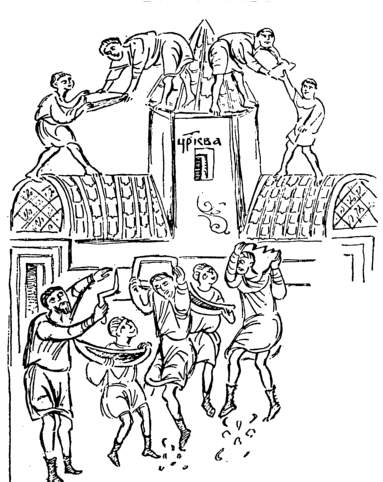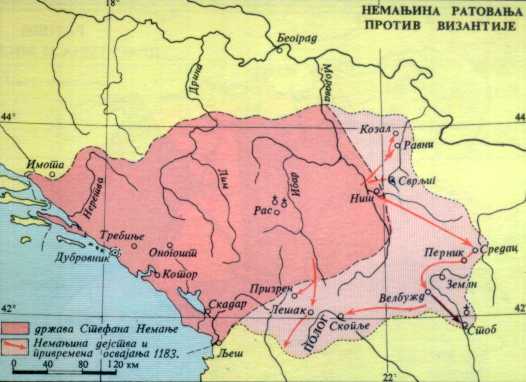

Building of a church
"Munich" Psalter
Stephan Nemanja entered the historical scene at the end of the 12th century. Young Nemanja came to "Niš, the town of glory" upon the invitation of the Emperor Manuel Comnenus (1143-1180). The Emperor, being amased by the young man's wisdom, awarded him a respectable court title of "the imperial dream". It might have not been a pure coincidence that it happened in Niš, the birthplace of St. Czar Constantine. Stephan Nemanja conquered Niš for the first time in 1183, as a Grand Duke then, penetrating deeply into the Byzantine territory, all the way to Sofia. Having well known the importance of Niš, he planned to move the capital of his state to this town. The next year, on July 27th 1189, he met with Frederick I Barbarossa in this "most famous of all of his towns". Niš fell again under the government of Byzantium in 1190, and it is mentioned as a Byzantine town in 1198.
Nis entered the 13th century as a Serbian town. However, it was soon occupied by Bulgarians, already in 1203. From that period, when Niš was under the Ohrid Archbishopric, more precisely in 1204, we know of the Niš bishop Kirik and the Church of St. Procopius.
The independent Serbian Church (1219) established the Toplica Diocese, with the seat in the Monastery of St. Nicholas in Toplica. The territory of Niš Eparchy, that had been under the Ohrid Autocephalous Church from 1020, got united with the Serbian Church by that act. Many years later, the name Nikodim as the bishop of Niš appeared in the Gospel that was written in Svrljig 1279.

NEMANJA'S CAMPAIGNS AGAINST BYZANTIUM
The town of Nis was alternately occupied by the Byzantines and Bulgarians until 1330, when Nis and its district were adjoined to the state of Serbia. Nis was under Serbian authority all the way during the reign of Stephan Dušan (1331-1355). A legend has survived from this period about Czar Dušan giving Communion to his army in the Mother of God's Monastery in Gabrovac. Even in the Pre-Kosovo Serbia, Niš was a part of the Prince Lazar's state. It is assumed that the Church of St. John in Orljane, located on the hill of Komniga, was frescoed in that period of peace and economic stability.
SERBIA DURING THE REIGN OF CZAR DUŠAN